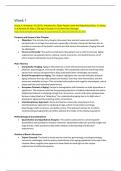Week 1
Komp, K. & Aartsen, M. (2013). Introduction: Older People under the Magnifying Glass. In: Komp,
K. & Aartsen, M. (Eds.), Old age in Europe (1-13). New York: Springer.
http://link.springer.com.proxy-ub.rug.nl/book/10.1007/978-94-007-6134-6
Purpose and Scope of the Chapter
• Objective: This introductory chapter discusses how societal views and scientific
perspectives on old age have evolved, especially in Europe. Komp and Aartsen aim to
provide an overview of the book’s content and the various dimensions of aging that will
be addressed.
• Focus on Diversity: The authors emphasize that aging is not a uniform process. Aging
experiences vary greatly due to cultural, social, economic, and health factors, all of
which impact individuals' lives as they grow older.
Main Themes
• Complexity of Aging: Aging is described as a multi-dimensional process that includes
physical, psychological, and social changes. This complexity requires examining older
adults from various perspectives to fully understand their challenges and needs.
• Social Perspectives on Aging: The chapter highlights that societal attitudes towards
aging influence the way older people are treated, how they view themselves, and the
resources available to them. This includes both positive and negative stereotypes, which
shape policies and individual experiences.
• European Context of Aging: Europe’s demographic shift towards an older population is
significant. The authors note that the growing proportion of elderly individuals has led to
heightened interest in studying old age from economic, social, and policy perspectives.
Europe is described as a "laboratory" for understanding aging due to its high rate of
population aging and the resulting policy innovations.
• Interdisciplinary Approach: Komp and Aartsen stress the importance of an
interdisciplinary approach to studying old age, which incorporates sociology,
psychology, health sciences, and public policy. This approach allows for a holistic
understanding of aging that can better address the needs of the elderly population.
Methodological Considerations
• Quantitative and Qualitative Analysis: The authors advocate for combining both
quantitative and qualitative research methods. Quantitative data can provide insight into
large trends, while qualitative data offers deeper understanding of individual
experiences.
Outline of Book’s Structure
• Topics Covered: The book is structured to cover bio-gerontology, social gerontology,
economic challenges, and the policy implications of an aging population in Europe. Each
chapter offers insights from experts in these fields to shed light on the unique
experiences of elderly Europeans.
,Ankri, J. & Cassou, B. (2013). Bio- and Health Gerontology: How Ageing Changes our Bodies. In:
Komp, K. & Aartsen, M. (Eds.), Old age in Europe (15-28). New York: Springer.
http://link.springer.com.proxy-ub.rug.nl/book/10.1007/978-94-007-6134-6
Overview and Scope
• Focus: This chapter examines the biological and health aspects of aging, discussing how
the aging process affects the body at a cellular, systemic, and functional level. Ankri and
Cassou provide an overview of common physiological changes and health challenges
associated with aging, explaining how these changes impact daily life and health care
needs.
Key Biological Changes in Aging
• Cellular Aging: Aging is a result of accumulated cellular damage, influenced by factors
such as oxidative stress and genetic programming. This cellular damage contributes to
the overall decline in bodily function and resilience.
• Physical Decline: The authors outline key changes in various systems of the body,
including:
o Musculoskeletal System: Loss of muscle mass (sarcopenia) and bone density
(osteoporosis) increases the risk of fractures and physical disabilities.
o Cardiovascular System: Aging causes blood vessels to become less elastic and
may lead to increased blood pressure and a higher risk of cardiovascular
disease.
o Respiratory System: Lung function declines, making breathing less efficient and
increasing the vulnerability to respiratory illnesses.
o Immune System: The immune system weakens (immunosenescence), making
older adults more susceptible to infections and slower to recover from illnesses.
o Cognitive Decline: Cognitive abilities such as memory, reasoning, and
processing speed may decline, though the extent and onset vary among
individuals. Conditions like Alzheimer’s disease and dementia are also more
common in older adults.
Health Challenges and Chronic Illness
• Increased Risk of Chronic Diseases: Ankri and Cassou discuss that aging is
accompanied by a higher prevalence of chronic conditions such as diabetes,
hypertension, arthritis, and respiratory diseases. Managing these conditions often
requires long-term medical care and lifestyle adjustments.
• Impact of Polypharmacy: Older adults are more likely to use multiple medications
(polypharmacy), which increases the risk of adverse drug reactions and complications.
Proper management of medications becomes a crucial aspect of care.
• Functional Impairments: The chapter emphasizes that physical and cognitive changes
can lead to functional impairments that affect an individual’s ability to live
independently. Mobility issues, sensory declines (e.g., hearing and vision loss), and
difficulties in performing activities of daily living (ADLs) are discussed as common
concerns.
Quality of Life Considerations
• Focus on Preventive Care: To improve quality of life, Ankri and Cassou advocate for
preventive measures, including regular exercise, healthy diet, and social engagement,
, which can mitigate some effects of aging and promote better physical and mental
health.
• Role of Healthcare Systems: Healthcare systems play a significant role in managing the
health of older adults. The authors discuss how health systems in Europe are
increasingly adapting to meet the needs of an aging population by emphasizing
preventive care and chronic disease management.
Challenges and Implications for Policy
• Economic and Social Burden: The chapter concludes by addressing the economic and
social implications of these health challenges, particularly the increased demand for
healthcare resources, long-term care, and support services. The authors highlight the
need for policies that support healthy aging and provide adequate resources for both
preventive care and chronic disease management.
Conclusion
• Integrating Bio- and Social Gerontology: Ankri and Cassou argue that understanding
aging from a biological and health perspective is crucial for developing effective
interventions and policies. They call for collaboration between bio-gerontology and
social gerontology to address the diverse needs of the aging population
comprehensively.





